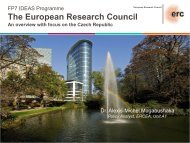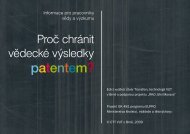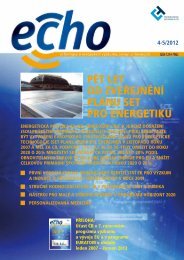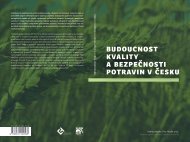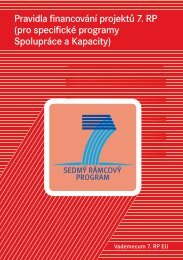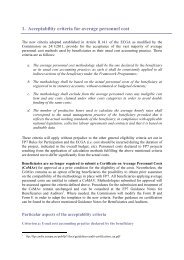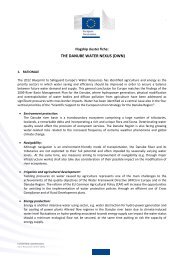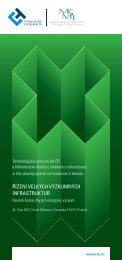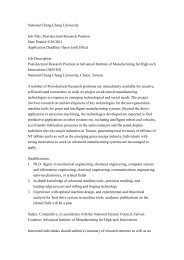Guide to Research and Innovation Strategies for Smart Specialisation
Guide to Research and Innovation Strategies for Smart Specialisation
Guide to Research and Innovation Strategies for Smart Specialisation
Create successful ePaper yourself
Turn your PDF publications into a flip-book with our unique Google optimized e-Paper software.
a mutual underst<strong>and</strong>ing of the drivers affecting all the partners. Universities will appreciate<br />
the opportunities that their regions present <strong>for</strong> their activities as 'living labora<strong>to</strong>ries' opened <strong>to</strong><br />
international linkages; their private <strong>and</strong> public partners will benefit from their expertise <strong>for</strong><br />
translating knowledge in<strong>to</strong> innovation.<br />
How <strong>to</strong> act?<br />
Universities <strong>and</strong> other knowledge institutions should be closely linked <strong>to</strong> the process of<br />
designing national/regional innovation strategies <strong>for</strong> smart specialisation. They are needed <strong>to</strong><br />
develop several steps of these strategies <strong>and</strong> they can also act as intermediary bodies <strong>for</strong> the<br />
implementation of several delivery instruments that are described in this guide.<br />
For the next programming period, the investments priorities proposed under Cohesion Policy<br />
cover these aspects with an emphasis on connecting universities <strong>to</strong> regional growth <strong>and</strong><br />
developing stronger partnerships within the knowledge triangle. To have complete<br />
in<strong>for</strong>mation on these processes in<strong>for</strong>mation should be sought in the practical guide<br />
'Connecting universities <strong>to</strong> regional growth' that presents processes <strong>and</strong> delivery mechanisms<br />
<strong>to</strong> build capacity <strong>and</strong> incentives <strong>for</strong> universities <strong>and</strong> their regional partners <strong>to</strong> work <strong>to</strong>gether.<br />
Based on examples, it explores the following issues:<br />
• establishing a regional higher education partnership <strong>to</strong> better underst<strong>and</strong> the regional<br />
situation <strong>and</strong> <strong>to</strong> overcome the barriers, with a possible technical assistance budget,<br />
• ensuring mechanisms allowing universities <strong>and</strong> business in the region <strong>to</strong> cooperate in<br />
curricula design <strong>and</strong> in jointly delivering education in an innovative way, fostering<br />
graduates with regional relevant competences <strong>and</strong> with transversal skills including <strong>and</strong><br />
entrepreneurial attitude,<br />
• mapping the regional higher education system in terms of their degree awarding ability,<br />
research activities <strong>and</strong> possible cooperation with regional partners,<br />
• assessing the connectivity of the universities <strong>to</strong> the regional public <strong>and</strong> private sec<strong>to</strong>rs <strong>to</strong><br />
move <strong>to</strong>wards a situation where universities are key players,<br />
• selecting, designing <strong>and</strong> evaluating interventions that strengthen the connectivity of<br />
universities in the region <strong>to</strong> the region, by moving from simple <strong>to</strong> complex projects.<br />
In the future programming period 2014-2020, support under the European Agricultural Fund<br />
<strong>for</strong> Rural Development (EAFRD) could be provided <strong>to</strong> Universities in the following areas:<br />
• Knowledge transfer <strong>and</strong> in<strong>for</strong>mation actions – <strong>for</strong> provision of vocational training <strong>and</strong><br />
skills acquisition actions, demonstration activities <strong>and</strong> in<strong>for</strong>mation actions. These should<br />
be provided <strong>for</strong> persons engaged in agriculture, food <strong>and</strong> <strong>for</strong>estry sec<strong>to</strong>r, l<strong>and</strong> managers<br />
<strong>and</strong> other economic ac<strong>to</strong>rs which are SMEs operating in rural areas,<br />
• Advisory services <strong>for</strong> the improvement of the economic <strong>and</strong> environmental per<strong>for</strong>mance<br />
as well as the climate friendliness <strong>and</strong> resilience of the farms, <strong>for</strong>est enterprises <strong>and</strong> rural<br />
SMEs, <strong>and</strong>/or relevant investments,<br />
• Studies <strong>and</strong> investments associated with the maintenance, res<strong>to</strong>ration <strong>and</strong> upgrading of<br />
the cultural <strong>and</strong> natural heritage of villages <strong>and</strong> rural l<strong>and</strong>scapes, including related socioeconomic<br />
aspects,<br />
• Co-operation among different ac<strong>to</strong>rs in the Union agriculture, food chain, <strong>for</strong>estry sec<strong>to</strong>r<br />
<strong>and</strong> among other ac<strong>to</strong>rs (including Universities) that contributes <strong>to</strong> achieving the<br />
objectives <strong>and</strong> priorities of rural development policy (e.g., pilot projects; new products,<br />
processes <strong>and</strong> technologies; public-private partnerships; etc.). This covers also support<br />
79



